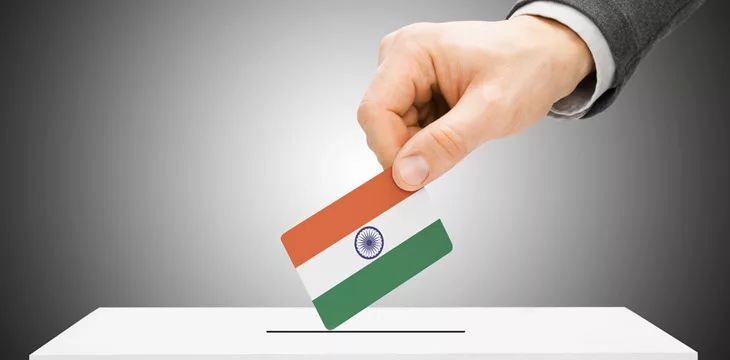|
Getting your Trinity Audio player ready...
|
2024 is the year of artificial intelligence (AI) for India’s national elections, as the world’s biggest democracy uses AI extensively for poll campaigns and language translations.
India, the world economy’s ‘beacon of hope’, went into polls on April 19 and will continue until June 1. The 2024 general elections are being held in seven phases to elect 543 members of the lower house of Parliament or Lok Sabha. Votes will be counted, and results will be declared on June 4.
The largest election in human history—which has about 970 million registered voters—is not only using AI to target voters through dozens of language translations, but also using AI to create deepfake videos and conversational bots, raising concerns over the misuse of the technology.
“AI-generated deepfakes and voice clones of political leaders are being circulated on social media and messaging platforms like WhatsApp to deliver positive or negative messaging about candidates or [political] parties,” Rajagopal Menon, Vice President of WazirX, one of India’s largest digital asset trading platforms, told CoinGeek.
“This is just the tip of the iceberg,” Pradeep Gooptu, founder secretary of Bengal Initiative, an Indian think tank, told CoinGeek.
“I believe AI will play an increasingly critical role in electoral tracking, analysis, and influencing, but I fear this may lead to erosion of privacy and greater intrusion into the private lives of citizens by government agencies—which are unfortunately controlled by the political party in power in that sphere,” Gooptu added.
In an AI-generated fake video, top Indian actors—Aamir Khan and Ranveer Singh—are shown criticizing Prime Minister Narendra Modi for failing to keep his promises and persuading voters to vote for an opposition political party.
Likewise, a fake video of Union Home Minister Amit Shah is reportedly heard saying that his Bharatiya Janata Party would do away with reservations for backward classes, a sensitive issue in India.
As a result, the Election Commission of India—established by the Constitution of India and empowered to conduct free and fair elections—issued an advisory to political parties warning them against misuse of AI tools to create deepfakes and spread misinformation and urging them to maintain the sanctity of the electoral process.
Election campaigning in the world’s fastest-growing major economy has traditionally happened through public rallies and door-to-door outreach, but the last Indian general election—held in 2019—saw the widespread use of digital media. With 300 million Facebook users and over 200 million on WhatsApp, which was more than any other country, many touted the 2019 election as the ‘WhatsApp’ election.
However, general elections in 2024—where Modi is expected to secure a rare third consecutive term—is the first time almost all political parties and candidates are using AI extensively to reach voters and are estimated to spend more than $50 million on AI-generated election campaign materials.
Touted as the year of elections, over 2 billion voters across 50 countries, including the United States, the European Union, and India, are heading into polls in 2024. However, elections in India are expected to be the world’s most expensive as candidates and political parties are estimated to spend roughly $14.4 billion on elections this year. That figure was about $7.2 billion during the last national elections in 2019.
“The 2024 elections may be a trial by fire for Indian democracy in the age of AI. However, we may use AI to reinforce rather than weaken our democratic principles if we combine innovation, vigilance, and civic involvement in the appropriate ways. The stakes are quite high, yet it won’t be simple,” Raj Kapoor, founder of India Blockchain Alliance and chairman of Global Alliance for Ethical AI Innovation, told CoinGeek.
“AI will be a significant, double-edged sword. A lot will depend on what stakeholders do. Will political parties give in to the pressure of manipulation or employ AI responsibly? Will law enforcement properly balance restriction and free expression? Will the public be able to handle the difficulty of navigating a post-truth, hyper-personalized information landscape?” Pointed out Kapoor.
AI for economic growth
India recently approved over $1.24 billion for the IndiaAI Mission, slated over the next five years. The financial infusion aims to boost the country’s AI ecosystem, innovation, and entrepreneurship.
“A landmark day for tech and innovation! The Cabinet’s approval for the IndiaAI Mission will empower AI startups and expand access to compute infrastructure, marking a giant leap in our journey towards becoming a global leader in AI innovation,” Modi had said on X.
Boosted by strong economic growth, Modi predicts that his party and allies will win more than 400 seats to have a majority for the next five years. The Modi-led government also intends to leverage AI to achieve its Viksit Bharat (developed India) goal by 2047. With 1.4 billion people—almost 18% of the global population—the economy of the world’s most populous nation is expected to grow at over 6.6% in the current fiscal year. India also aims to be a $5 trillion economy by 2028 and the world’s third-biggest economy, with emerging technologies like AI and blockchain as key catalysts for growth.
“[AI] is increasingly being embraced by [political] parties for campaigning and outreach. However, concerns are raised about the implications of using AI-generated content to influence a large, digitally diverse electorate with varying levels of online literacy,” Menon of WazirX pointed out.
“The increasing use of deepfakes and AI voices also points towards AI’s growing role, which could further expand in future elections as the technology advances and more voters become accessible online,” Menon added.
The uses
In the 2024 national elections, “Political parties are using AI-powered voice calls to virtually reach out to voters. The calls use AI to generate the voice of a local leader and dynamically respond to voter inputs with relevant replies. Resurrected AI-generated videos of deceased leaders like Karunanidhi and Jayalalithaa are being circulated, showing them promoting the current party leadership,” Menon said.
Modi has embraced AI innovations and uses voice cloning to replicate his speeches across eight languages, including Kannada, Tamil, Telugu, Malayalam, Bengali, Punjabi, Marathi, and Odia.
Modi is leveraging AI tools like ‘Bhashini’ to translate language during campaigns.
“AI is also being used to predict voter behavior and simulate electoral outcomes. Predictive models, fed with historical voting data, polling, and real-time social media sentiment, can forecast results with increasing accuracy. This allows parties to strategically focus their efforts on swing states and undecided voters,” Kapoor pointed out.
Images from social media can be used by computer vision to determine voter emotion. AI makes an unprecedented degree of tailored outreach possible, and political parties are leveraging the technology to understand each voter’s unique needs and beliefs.
“Technologically savvy political strategists in India see AI as a game-changer. Voters have also been micro-targeted with personalized messaging using machine learning algorithms, as AI has the potential to examine vast amounts of behavioral, psychographic, and demographic data. AI-driven chatbots interact with citizens round-the-clock, responding to their questions and collecting important data, and this has been widely adopted by most political parties,” Kapoor added.
India’s Aam Aadmi Party (AAP) has leveraged AI to maintain communication between its recently arrested leader, Arvind Kejriwal, and the public. The party has used AI tools to create a voice clone and convert his written message into spoken word.
“Campaigns can forge deeper connections and mobilize supporters more effectively than ever before,” Kapoor reiterated.
Combating misuse
The Indian government has used technology successfully to target the poor. It has also used technology to weed out fake beneficiaries from its welfare schemes, especially with Direct Benefit Transfers, a system to transfer subsidies directly to the public through their linked bank accounts.
“Logically, the same algorithm can be deployed to weed out fake votes or duplicate voters from voter lists. What technologies such as AI and blockchain get used for depends entirely on the problem that one is attempting to solve,” Menon pointed out.
To be fair, India currently does not have a clear regulation for AI-generated content, except for a list of guardrails, including watermarking AI-generated content and testing AI-backed content for potential harm before releasing it to the public. India is expected to release a draft regulatory framework for AI by July to use the technology for economic growth while setting up guardrails to prevent misuse.
“Artificial intelligence undeniably holds significant potential for the future of the electoral system, with ongoing discussions and pilot projects exploring its adoption and implementation. AI’s ability to streamline various aspects of the electoral process, including voter registration, outreach, and fraud detection, makes it an attractive option for improving efficiency and accuracy. Furthermore, AI-driven predictive analytics can provide valuable insights into voter behavior and preferences, enabling more targeted campaign strategies and voter engagement efforts,” Kapoor pointed out.
However, concerns about privacy, security, and transparency loom large. AI algorithms require a massive amount of data, raising questions about the collection, storage, and protection of voter information. The opacity of AI decision-making processes can erode trust in the electoral process, especially if the algorithms exhibit biases or lack accountability.
“The political and regulatory landscape surrounding AI adoption in elections is complex. Policymakers must navigate issues such as data privacy regulations, cybersecurity measures, and ethical standards to ensure the responsible and equitable use of AI in the electoral system. So, while AI holds promise for enhancing the electoral system’s efficiency and effectiveness, widespread adoption hinges on addressing ethical, regulatory, and societal concerns to ensure a transparent, secure, and inclusive electoral process,” Kapoor said.
In order for artificial intelligence (AI) to work right within the law and thrive in the face of growing challenges, it needs to integrate an enterprise blockchain system that ensures data input quality and ownership—allowing it to keep data safe while also guaranteeing the immutability of data. Check out CoinGeek’s coverage on this emerging tech to learn more why Enterprise blockchain will be the backbone of AI.
Watch The Web3 trifecta: AI, metaverse & blockchain

 12-29-2025
12-29-2025 




